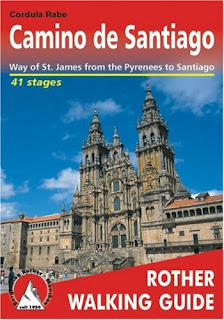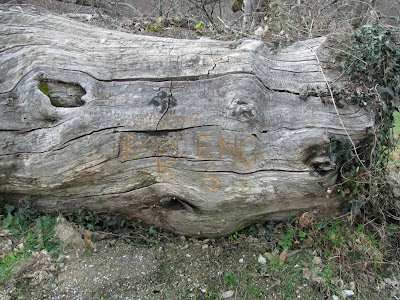 That night, in Calzadilla de la Cueza, a village with a name longer than its main street, I sat alone in front of the monitor, tucked away in a dark back corner of the room, trying to get to grips with a keyboard with only blank keys – the letters having been completely worn away by the fingertips of thousands of pilgrims who had preceded me. As I looked down in exasperation at this tired and worn keyboard, I suddenly had a wave of recognition wash over me. I felt the presence of all those pilgrims who’d sat where I was sitting; who had tried to have their fingers remember which keys represented the letters they needed to write a message home to loved ones – to tell them they were still safe on their pilgrimage. I could
That night, in Calzadilla de la Cueza, a village with a name longer than its main street, I sat alone in front of the monitor, tucked away in a dark back corner of the room, trying to get to grips with a keyboard with only blank keys – the letters having been completely worn away by the fingertips of thousands of pilgrims who had preceded me. As I looked down in exasperation at this tired and worn keyboard, I suddenly had a wave of recognition wash over me. I felt the presence of all those pilgrims who’d sat where I was sitting; who had tried to have their fingers remember which keys represented the letters they needed to write a message home to loved ones – to tell them they were still safe on their pilgrimage. I couldalmost hear them cursing under their breath when they typed and the wrong letters came up, turning their messages into gobbledegook. I could almost feel their breath on my back as they paced the floor waiting for me to finish so they could have their turn. I could almost see their smiles as the screen lit up and they found messages in their inbox from someone back home telling them that they were missed. In that moment of solitude, I felt utterly and wholly part of this confraternity of the Camino. At the same time, I was aware that this feeling had slowly been creeping up on me for a long time. In fact, it was a feeling that had started to manifest itself on that very first night in Roncesvalles when I shared a beer with Thorsten and Akira and we spoke late into the night – about why we were on the Camino, about our fears and hopes and expectations.
It was over that first meal from the pilgrim’s menu, bought for the princely sum of eight euros – a delicious and nourishing broad bean and potato soup, a huge plate of tender veal stew and a large glass of ice-cold, frothy beer – that we quickly recognised in each other fellow-pilgrims.
Perhaps it was that the three of us were starting our pilgrimage from the same place and at the same time. There was definitely something special about the bond formed between we strangers who had embarked on a journey together. Or perhaps it was that we’d been brought together by a common purpose. As individuals, we were different in every way – age, background, culture and language – yet we sensed subconsciously that
where one lacked, another might be able to compensate. Each individual’s assets and characteristics complemented those of the others – a type of a synergy where the combined whole of our little band was far, far greater than the sum of the individuals.
In his book on the Camino, Coelho speaks of being more accessible to others around you on the journey because instinctively you know that they may be able to help you in difficult situations. The Camino was in many ways a survival course: you had to dig deep to find the resources within yourself in order to get through each day. It was astonishing to find resources you’d never been aware of, but it was also frightening when a needed resource was simply not there, no matter how deep you dug. And it was then that you came to appreciate the other pilgrims around you.
Everyone has talent. Sometimes we only discover that talent late in life, but the talent is there for the finding. And the Camino was the perfect place for the ‘big reveal’ of those hidden talents. If I could find resources within myself that I’d never known I had, so could every other pilgrim. And it was the pooling of those resources that created the bond among pilgrims. Not only did each have the wondrous pleasure of discovering their own latent potential, but each also had the unrivalled pleasure of being with other people who had a need for their particular talent.
Later I learned that for many pilgrims this was the one special aspect of their Camino – the remarkable goodwill, generosity and voluntary interdependence among pilgrims. I frequently heard pilgrims talk about this wonderful phenomenon of the Camino. It could be something that a fellow-pilgrim had offered in the form of advice or spiritual guidance, clothing or toiletries, water or food. Often the biggest source of surprise was the fact that the generosity came from someone who ‘wasn’t even a Christian’. There seems to be an unspoken assumption that someone who
walks the pilgrimage has to have some degree of religious motivation, and the expectation is that, to show kindness, their religion must be Christian. Whenever this subject came up in conversation, I was astounded at people’s preconceived ideas about other religions, because almost every time an act of random kindness surprised a pilgrim, it came from a non-Christian. My only surprise was that those who offered assistance seldom realised that what they were really offering was not necessarily something tangible or material, but something of themselves. They were releasing a small piece of their own spirit into the universe, and the universe was the richer for it.
I have always believed that ‘what goes around, comes around’. My smile, my positive attitude, my helpfulness, my generosity of time and energy almost unfailingly generate a similar response from people around me – friends and strangers alike. The payback may not happen immediately, and perhaps it will come from someone completely different, but people’s actions and behaviour towards you are often a reflection of what you transmit. And yet many pilgrims seemed to find this to be the most amazing thing about their pilgrimage, because they’d obviously not come across this side of the human spirit very often before. How incredibly sad that people should be surprised at the random kindness of others; but how incredibly wonderful that they make this discovery on the Camino. For this seemed to be the way of the Camino – bringing the spirit of people together from all ends of the planet, all walks of life, all faiths and creeds, but with a single goal, to walk ‘the Way under the Stars’.
Whatever it was that acted as the glue binding us together, my little ‘Camino family’ was formed that night: Thorsten, a 24-year-old university student from Cologne; Akira, a 38-year-old gay musical theatre actor from Japan; and me, a 57-year-old Eurocentric African woman from France. And even on that first night we knew the bond between us was stronger than most people experience among their blood relatives. ‘You two are my Camino family,’ Akira said many times during the
following three weeks. ‘You are my Camino mother and Thorsten is my Camino father.’ That Akira was years older than Thorsten, whom he called his ‘father’, and was possibly not quite young enough to my ‘son’ was neither here nor there. For once, age was not the issue, and for me this was wonderfully refreshing. The three of us – without having to say anything about it – felt that a close bond had been forged that night, and for all of us the bond was to prove very important over the next few weeks.
.jpg)

.jpg)
.jpg)

.jpg)
.jpg)
.jpg)
.jpg)


.jpg)


.jpg)

.jpg)




.jpg)









.jpg)

















